 Volcanoes are believed to have been the most dangerous natural disaster in planet Earth. It may knock down an entire forest in seconds; it may also trigger other natural disasters such as earthquakes, tsunamis, floods and rockfalls. Volcanoes may become a threat to mankind and its habitat.
Volcanoes are believed to have been the most dangerous natural disaster in planet Earth. It may knock down an entire forest in seconds; it may also trigger other natural disasters such as earthquakes, tsunamis, floods and rockfalls. Volcanoes may become a threat to mankind and its habitat.
What is the definition of a volcano? A volcano is actually a rupture in the crust of a planetary-mass object, such as Earth, that when a pressure builds up, it allows hot lava, volcanic ash, and gases to escape from a magma chamber below the surface through an eruption.
There are many types of volcanoes; one of the most notable features is submarine volcanoes or under the ocean volcanoes. Interestingly, 80% of the Earth’s volcanic activities can be found under the ocean and the total number of these under ocean volcanoes is approximately 1 million. Most of these under the ocean volcanoes are located near the mid-ocean ridges, an area of the tectonic plate movements. This area accounts for three quarter of the magma output on Earth but most of these volcanoes are being underestimated because they are located 8,500 feet underwater on average. (see also: Deep Ocean Ecosystems)
Differences between land volcanoes and ocean volcanoes
Under the ocean volcano is different than the other types of volcanoes because of the place where it is found. Unlike the land volcanoes, under the ocean volcanoes are mostly hard to detect and discover. Although it is inside the ocean, those volcanoes can still produce eruptions, like the volcanoes on the land. While active, these under the ocean volcanoes will erupt and this eruption produces the shape of the sea floor. Out of a million of all under the ocean volcanoes, the scientists believed that thousands of them are active. (see also: effects of Greenhouse)
The deposits that are produced as the aftermath of the eruption of the under the ocean volcanoes can be very different compared to the deposits of the land volcanoes as they are located under the ocean. Volcanologists, geologists whose specializes their study in the formation and the activity of volcanoes, are actually hesitating on whether under the ocean volcanoes are possible to erupt explosively.
This is due to the creation of the high pressure by the water bubbles are hard to form in the magma and lava. Despite this debate, some of the volcanoes are believed to have erupted explosively that they created a caldera. (See also: Salinity of Ocean Water)
Another difference that can be found on under the ocean volcanoes is the shape of the lava flows; from land volcanoes, the flows tend to blocky, while from under the ocean volcanoes, the flows tend to be pillow-like. When the crust of a flow split and the lava comes out, it flows at a very short distance and solidifies, that is when those pillow-like lava flows are created.
The process then continues and repeats and this continuation creates the new piece of lava and creates a large stack of pillows. Other lava shapes that can be found from the under the ocean volcanoes are tumuli and sheet flows. (See also: Endangered Sea Turtles List)
Volcanic Ecosystem
Like all other volcanoes, under the ocean volcano also has a unique array of volcanic ecosystem. As has been mentioned before, under the ocean volcanoes are generally located at mid-ocean ridges. Here the hydrogen sulfide and water plus some other minerals exit the hydrothermal vents (black smokers). This creates an ecosystem that depends on sulfur other than sunlight; some of the organisms that can be found are tube worms, giant clams, mussels and other organisms. (See also: Surface of Tension Liquids)
Thus, they are located under the ocean, most of underwater volcanoes often go unnoticed. They may erupt suddenly without any obvious signs because the usual signs are very hard to be detected under the ocean. Eruption may come from an active volcano, whereas it is estimated that currently there are 5,000 active volcanoes that are under the ocean.
Their size varies, furthermore, some may stand alone while other may form ridges with other volcanoes, and even sometimes they can be very high that they rise above the surface and forming an island. (see also: Sea Erosion)
The reason of the rising above the surface is the composition of the under the ocean’s ash, lava and debris that come up during the volcanic eruption. One of these examples is Hawaiian Islands; with more than 2,400 km long, it is one of the longest and largest volcanic ridges in the world. Here are the other 12 most amazing volcano under the ocean from across the world:
1. Molokini Carter, Maui, Hawaii
 Despite of being one of the most popular tourist destinations, Molokini Crater was formed due to the under ocean volcanic eruption when the land mass of Maui moved over hot spots in the Earth’s tectonic plates. This eruption is believed to have happened since 230,000 years ago.
Despite of being one of the most popular tourist destinations, Molokini Crater was formed due to the under ocean volcanic eruption when the land mass of Maui moved over hot spots in the Earth’s tectonic plates. This eruption is believed to have happened since 230,000 years ago.
Nowadays, this crescent shaped uninhabited “island” is visited for ocean activities, such as scuba diving and snorkeling. It is favored because of the shape of the islet that protects divers from powerful currents and waves.
See also : Ocean Layers – Sea Salt Facts
2. West Mata
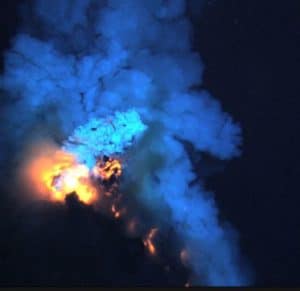 West Mata is located 200 kilometers southwest of the Samoas and it is an under the ocean volcano with approximately 1,100 meters depth. Although detecting and observing a deep ocean volcano is a difficult task, in the year 2008 scientists discovered this underwater volcano during a survey of the northeast Lau Bason. A year later, in May 2009, West Mata erupted at 4,000 feet below the surface in an area bounded by Fiji, Tonga and Samoa of the Pacific Ocean region.
West Mata is located 200 kilometers southwest of the Samoas and it is an under the ocean volcano with approximately 1,100 meters depth. Although detecting and observing a deep ocean volcano is a difficult task, in the year 2008 scientists discovered this underwater volcano during a survey of the northeast Lau Bason. A year later, in May 2009, West Mata erupted at 4,000 feet below the surface in an area bounded by Fiji, Tonga and Samoa of the Pacific Ocean region.
The eruption was carefully observed by using a remotely operated underwater vehicle, Jason 2 ROV. Both of the eruption were given a name, the first eruption was called Hades, while the second one was Prometheus. These continuous eruptions produced gas-filled lava bubbles up to 1 meter wide. The scientists even said that the gas flows through the glowing lava looked like a flame in its appearance.
The West Mata volcano is producing Boninite lavas, a type of lava that has only been seen on an extinct volcano that is older than a million years ago and it is believed to be among the hottest erupting on Earth. This active Boninite eruption has provided an opportunity for scientists to discover more about magma formation. West Mata volcano also has a unique feature as the water from the volcano is very acidic and the only organisms that can survive the water’s acidity are shrimps. (see also: oceans in the world)
3. Morro Rock, California
 When lava hardens within a vent on an active volcano, it transforms into a volcanic landform which sometimes is known as volcanic neck or lava neck. Morro Rock which is located in Morro Bay, California is one of the examples. It is studied that 20 million years ago, a series of volcanic plugs named “Nine Sisters” happened and the eruption from the under ocean volcano created this volcanic plug.
When lava hardens within a vent on an active volcano, it transforms into a volcanic landform which sometimes is known as volcanic neck or lava neck. Morro Rock which is located in Morro Bay, California is one of the examples. It is studied that 20 million years ago, a series of volcanic plugs named “Nine Sisters” happened and the eruption from the under ocean volcano created this volcanic plug.
Nowadays, the surrounding area of the rock can be visited, while climbing on the rock is prohibited as to prevent the disturbance of the life of the flora and fauna on the rock. (see also: Ocean Animals). To conserve the life of the ocean’s habitat and the ocean’s wildlife, Morro Bay is protected by the government.
4. Banua Wuhu, Indonesia
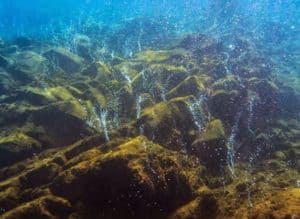 Banua Wuhu is located in the Sangihe Islands, 45 kilometers south of Awu, Indonesia. It is a deep ocean volcano that rises more than 400 meters above the sea floor and the top almost reaches the surface and because of this, it forms a shallow shoal at 5 meters depth. During some of its eruption, Banua Wuhu has created islands that are temporary because they are eroded subsequently by waves.
Banua Wuhu is located in the Sangihe Islands, 45 kilometers south of Awu, Indonesia. It is a deep ocean volcano that rises more than 400 meters above the sea floor and the top almost reaches the surface and because of this, it forms a shallow shoal at 5 meters depth. During some of its eruption, Banua Wuhu has created islands that are temporary because they are eroded subsequently by waves.
The last known eruption of this Banua Wuhu is around the year 1919. Sangihe Islands is known to be the region of many under the ocean volcanoes, such as Submarine 1922, and other active and non-active volcanoes. (See also: Ocean Plants)
5. Eldfell Volcano, Heimaey Island, Iceland
 Because of its location, Iceland region is a region with frequent volcanic activities. One of the best known volcanic eruptions in the world is Eldfell volcano. The Eldfell Eruption of 1973 is the name best known for the catastrophic under ocean volcanic eruption that happened on 23rd January 1973. (See also: How to Prevent El Nino)
Because of its location, Iceland region is a region with frequent volcanic activities. One of the best known volcanic eruptions in the world is Eldfell volcano. The Eldfell Eruption of 1973 is the name best known for the catastrophic under ocean volcanic eruption that happened on 23rd January 1973. (See also: How to Prevent El Nino)
The name “Eldfell” itself in Icelandic means Mountain of Fire. The eruption, which is located on the eastern side of Heimaey in the Westman island, nearly led to a permanent evacuation of the entire island of 5,000 population.
See also: Ocean Pollution – Endangered Seahorses
The eruption finished on 28th June 1973 or 157 days, with several aftermaths, such as destroying almost 400 hundreds of homes, covering and burying the entire town of Vestmannaeyjar in ash, and sending lava flows toward the harbor. Nowadays, the town has been restored and fishing companies are back. The island is the major contributor of Iceland’s total fish catch and it is one of the most important fishing centres in the nation.
6. Iwo Jima, Japan
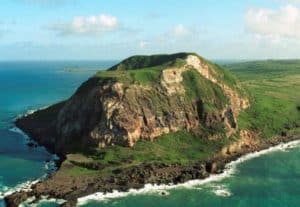 Iwo Jima, one of Volcano under the Ocean which means “Sulfur Island”, is one of the deep ocean volcanoes located in Japan with an aprroximate area of 21 kilometers square. The cone in Iwo Jima is called Mount Suribachi, which is at the highest point of 160 meters. Iwo Jima is becoming famous after the battle involving United States and Britain versus Japan, which is known by the name “Battle of Iwo Jima”.
Iwo Jima, one of Volcano under the Ocean which means “Sulfur Island”, is one of the deep ocean volcanoes located in Japan with an aprroximate area of 21 kilometers square. The cone in Iwo Jima is called Mount Suribachi, which is at the highest point of 160 meters. Iwo Jima is becoming famous after the battle involving United States and Britain versus Japan, which is known by the name “Battle of Iwo Jima”.
Iwo Jima morphology is different than the other island arc volcanoes, as it is unusually flat and featureless for a volcanic island. Besides its morphology. (see also: Ocean Coral Reef)
Then, its composition is also different than the other, as Iwo Jima’s lavas are rich in potassium and other useful elements and its lavas are known as Shosohonites lavas. Historically, Iwo Jima has at least 10 well known eruption, most of them are small and non explosive and caused by the interaction of the magma and water. However, in 2015, volcanologists believe that Iwo Jima may bring threat as it is regarded as the most dangerous volcano and there is 30% chance that it may erupt explosively in this century. (see also: Ocean Phenomena)
7. Brothers Volcano, Kermadec Arc, New Zealand
 Brothers Volcano is a Pacific Ocean under the ocean volcano, 340 kilometers east of New Zealand’s White Island and lies 1,850 meters below the sea level. (See also: Marine Disasters)
Brothers Volcano is a Pacific Ocean under the ocean volcano, 340 kilometers east of New Zealand’s White Island and lies 1,850 meters below the sea level. (See also: Marine Disasters)
Within the oval outline of the Brothers Volcano, there is a 3 kilometers wide caldera with 300m-500m walls high. This caldera is studied to be formed around 37,000 – 51,000 years ago.
Caldera is a collapse of the mouth of the volcano that is formed by a major eruption. The caldera in Brothers Volcano is three times bigger than the White Island. (see also: Waves in Ocean)
The caldera walls host numerous hydrothermal vents and it is the most hydrothermally active volcano in Kermadec Arc region. The unique ecosystems, such as various bacteria and tubeworms, which rely on the hydrothermal fluids, are beneficial for the New Zealand’s biotechnology industry and the country’s economy. Although it is still unknown when Brothers Volcano was last erupted, but from the crater walls and the formation of a caldera, scientists concluded that the last eruption was explosive. (see also: Marine Protected Areas)
8. Vailulu’u, South Pacific Ocean
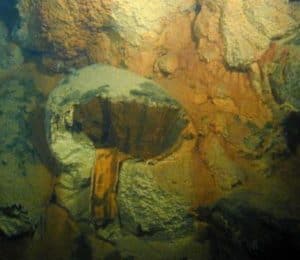 This volcanic seamount was discovered by Rockne Johnson, a geophysicist, on 18th October 1975. The base of Vailulu’u ranges 33 kilometers across the ocean floor and rises 4,200 meters high from the sea floor to a depth of 590 meters. The size and the appearance of Vailulu’u resemble Japan’s Mount Fuji.
This volcanic seamount was discovered by Rockne Johnson, a geophysicist, on 18th October 1975. The base of Vailulu’u ranges 33 kilometers across the ocean floor and rises 4,200 meters high from the sea floor to a depth of 590 meters. The size and the appearance of Vailulu’u resemble Japan’s Mount Fuji.
Like Brothers Volcano Vailulu’u summit also contains an oval shaped caldera with width of 2 kilometers and depth of 400 meters.
Meanwhile. this caldera has become the habitat of synaphobranchid eels Dysommina rugosa and is best known as the site of “Eel City”.
See also: Waves in Ocean
This active underwater volcanic cone is called Nafanua and it has been growing since 2001. The base of Nafanua is a toxic zone and covered by carcasses of dead fishes, squids, and crustaceans.
9. Kick ’em Jenny, Grenada
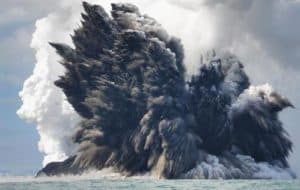 This volcano is also known as Mount Kick ‘em Jenny in which the name may be referring to the occasionally rough and extreme water.
This volcano is also known as Mount Kick ‘em Jenny in which the name may be referring to the occasionally rough and extreme water.
Although the name is quite funny, it actually represents an active under ocean volcano. It is located 8 km north of Grenada and on the floor of Caribbean Sea. (See also: Climate of the Ocean)
This volcano’s first known eruption happened in 1939 although scientists believe that there were many volcanic activities happened before that time. (see also: Ocean environment)
The 1939 Kick ‘em Jenny’s eruption was the largest and most destructive. It sent a cloud of ocean debris and steam as high as 275 meters into the air and generated a series of 2 meters high tsunamis to the northern part of Grenada and small tsunami to the west coast of nearby Barbados. Last know eruption happened in the year 2015. Because this volcano is still active, nowadays, there is a 5 kilometers safety zone around the volcano to deter adventurous scuba divers and snorkelers. (See also: Ocean Natural Resources)
10. Axial Seamount, Oregon
 Axial Seamount is an active under ocean volcano and a seamount on the Juan de Fuca Ridge, about 300 miles off the coast of Oregon. It is the youngest volcano of the Cobb-Eickelberg Seamount Chain. Generally, seamount is not an island because it does not reach the ocean’s surface; it is actually a mountain rising from the ocean seafloor. It is typically formed from an extinct volcano that rises abruptly.
Axial Seamount is an active under ocean volcano and a seamount on the Juan de Fuca Ridge, about 300 miles off the coast of Oregon. It is the youngest volcano of the Cobb-Eickelberg Seamount Chain. Generally, seamount is not an island because it does not reach the ocean’s surface; it is actually a mountain rising from the ocean seafloor. It is typically formed from an extinct volcano that rises abruptly.
Axial Seamount was first detected in the year 1970. Interestingly, the first under ocean eruption was detected at this seamount. The eruption had been proven to be following a 16 year cycle that scientist has been predicted in the year 2006. (See also: Effects of Sea Level Rise)
Axial Seamount was the site of NeMO, the world’s first underwater volcano observatory, and now has been chosen as the key node of the new cabled observatory as a part of National Science Foundation’s OOI (Ocean Observatory Initiative). (See also: Effects of Ocean Currents)
11. NW-Rota 1, Japan
 Other Volcano under the Ocean is in Japan. This active under the ocean volcano is also called Northwest Rota, it is located in the Pacific region and it is about 64 kilometers northwest of Rota Virgin Island.
Other Volcano under the Ocean is in Japan. This active under the ocean volcano is also called Northwest Rota, it is located in the Pacific region and it is about 64 kilometers northwest of Rota Virgin Island.
The peak of this volcano is 517 meters below the sea level. During the expedition of NOAA (National Oceanic and Atmospheric Administration) in 2003, they discovered this volcano.
On the year 2004, a minor under the ocean eruption was found and releasing a plume containing ash, debris, molten sulfur and rock particles to a hundred meters high. (see also: Types of Sea Urchins)
This eruption was coming from Brimstone Pit, an active vent at the southern slope of Northwest Rota, approximately 40 meters below the summit. (See also: Acidification of the Ocean)
12. Healy, Kermadec Arc, New Zealand
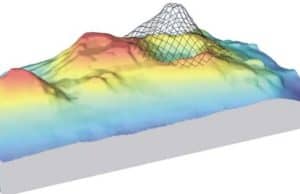 Besides Brothers Volcano, another under the ocean volcano located in the same region is Healy. The name of this volcano comes from Captain Jake Healy, a British-Australian explorer and navigator.
Besides Brothers Volcano, another under the ocean volcano located in the same region is Healy. The name of this volcano comes from Captain Jake Healy, a British-Australian explorer and navigator.
In the year 1360, this volcano erupted explosively and created a 12 kilometers square caldera whose rim reaches to 1,150 meters below sea level. While some of these volcanoes are amazing, but they may be are devastating for some.
See also: Marine Energy
Although natural disasters are something that are inevitable, as a mankind, we still need to dig further and explore more about these under the ocean volcanoes to find the pattern and more knowledge that may help us to prevent those disasters. Despite the advances in technology, detecting an eruption in under the ocean volcanoes is still a difficult task. (see also: Global Warming in Ocean)
In addition, although they were aware that under the ocean volcanoes are erupting, they did not have the capabilities and system to know where and when. Fortunately, in recent decades, volcanologists created a new system that listen to the acoustic wave produced by the vibrations under ocean. This system is different from the volcanic eruption detector on land that focuses on the vibration created during an earthquake. This new system helps scientist to identify the location of the under ocean volcanic eruption. (see also: Ocean Problems)